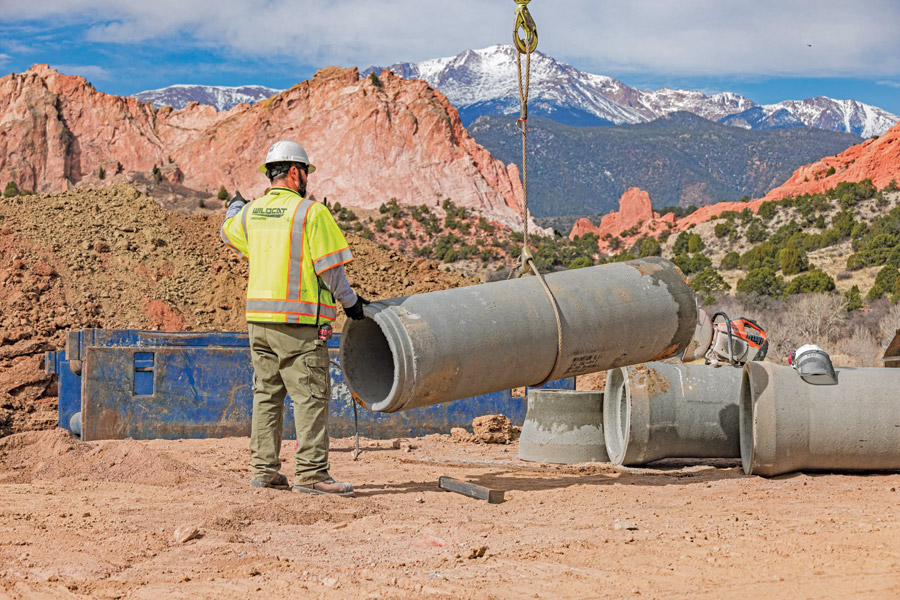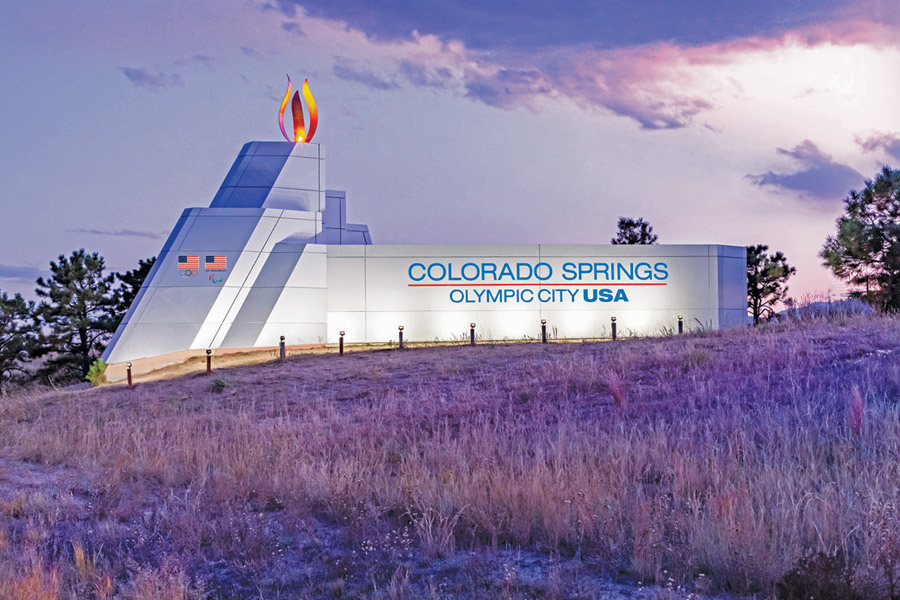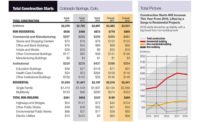Densification is in full swing in Colorado Springs: As of early 2023, about 25% of the 5,000 multifamily units now under construction in the city are downtown.
But that’s just scratching the surface when it comes to development at the foot of Pikes Peak, not to mention its summit.
Mayor John Suthers says the city has invested in itself to bring about the building boom. “When I got elected in 2015, we really started concentrating on persuading the public to invest in critical public infrastructure,” he says. “One of the arguments we made—which I think is incredibly valid—is that when people in the private sector see a community investing in itself, they are more likely to invest in the community.”
The plan is paying off, with the city’s GDP increasing from about $30 billion to $40 billion since Suthers’ election in 2015.
“The city has a lot of momentum,” says Bob Cope, Colorado Springs’ economic development officer. “It built slowly coming out of the Great Recession of 2008. We slowly recovered until 2015, and then we really started to take off.”

The city has caught up on deferred investment with an influx of $500 million in infrastructure projects.
Image courtesy of Lander Media
Infrastructure Investments
The 2008 financial crisis took a hatchet to the city’s budgets, leading to the need to play catch-up. “The city had deferred maintenance for decades while it continued to grow,” says Travis Easton, Colorado Springs’ director of public works. “It was only going to be getting worse.”
Several funding mechanisms underpinned infrastructure development. The Pikes Peak Rural Transit Authority is a regional effort to support road maintenance and public transit. “That’s a 1% sales tax that goes strictly into roads, bridges and things of that nature,” says Easton. “Over a 10-year authorization that currently ends in 2025, we’re going to have invested about $500 million into roadway infrastructure and capital projects.”
“When everybody’s on the same page ... it’s amazing what a city can do.”
—Jariah Walker, Executive Director, Colorado Springs Urban Renewal Authority
Since 2017, the city has also spent more than $160 million on stormwater infrastructure, while also prioritizing fire mitigation. “All of that effort was intentional and really part of attracting private investment into our city,” says Easton. “The proof is in the work.”
It’s also in the vote: Nearly 80 percent of voters approved a 10-year extension of the Pikes Peak Rural Transit Authority tax in 2022, a staggering number for a city known for its conservative politics.
While it doesn’t involve critical infrastructure, replacing the city-owned 1960s-era Summit House atop Pikes Peak with the new $65-million Summit Visitor Center (the 2022 ENR Mountain States Best Project) is emblematic of the city’s strategy.
“It was something we desperately needed, and we just put together a game plan,” says Suthers. “It’s an enterprise of the city. We can generate revenue for bonding from trips up Pikes Peak on the toll road, but we also figured, ‘We’ve got to go out and raise about $15 million privately,’ and we did it.”
City for Champions
City for Champions is a collection of four projects consisting of five distinct venues that will attract new visitors to Colorado Springs, the surrounding region and the state of Colorado. Encompassing the U.S. Olympic & Paralympic Museum; Weidner Field; Ed Robson Arena at Colorado College (CC); the William Hybl Sports Medicine & Performance Center at University of Colorado Colorado Springs; and the upcoming U.S. Air Force Academy (USAFA) Gateway Visitor Center, the City for Champions projects won $120.5 million in tax increment financing from Colorado’s Regional Tourism Act Program in 2013.
The projects got off to a slow start, but four of the five are now open for business. Suthers says City for Champions needed strong public-private partnerships to move forward when he assumed office. “What I inherited was conceptual,” he says. “We had to go out and put together the public-private partnerships to really get them off the ground.”
The museum wasn’t an issue, he notes, and neither was the Hybl Center, but the city needed partners for the sporting venues. “They simply did not pencil as purely public projects,” says Suthers.
The initial idea of an indoor/outdoor stadium evolved into two separate venues. “Having a bit of an entrepreneurial mindset and saying, ‘Okay, how do we make sure that we don’t lose these funds? How do we evolve and adapt?’” says Jariah Walker, executive director of the Colorado Springs Urban Renewal Authority, the financing entity for the City for Champions projects.
The local Switchbacks professional soccer team found a partner in Weidner Apartment Homes for the outdoor component, Weidner Field, which opened in 2021. As part of the deal, Weidner has developed several apartment complexes on the site, with more in the works.
The indoor component evolved into $9.2 million for the construction of the $65.7-million Ed Robson Arena for CC’s hockey games and other events. The college and donors picked up the remainder of the costs, and the venue opened in 2021.
Walker credits Cope for spearheading the City for Champions partnerships. “In my opinion, he should have a statue somewhere. In my heart of hearts, I really think if he’s not there—and he was there when the application was filled out and is still there today—there’s no way that these projects get done.”
But it took teamwork across the board, he adds. “When everybody’s on the same page and there’s no political issues and everybody feels the same, it’s amazing what a city can do.”

The U.S. Olympic & Paralympic Museum is a standout among the City for Champions projects.
Image courtesy of Lander Media
Downtown Development
Historically known for suburban-style development within its sprawling, 195-sq-mile city limits, Colorado Springs is in the midst of a “downtown renaissance,” Suthers says, citing about 3,000 new residential units since 2015. “It’s just been pretty remarkable.”
Peter Wysocki, director of planning and community development, highlights a “dramatic” boom in multifamily projects downtown and emerging nodes of density all over the city. The city issued more than 600 multifamily permits in 2022, up from 134 in 2015.
“When people in the private sector see a community investing in itself, they are more likely to invest in the community.”
—John Suthers, Mayor of Colorado Springs
“We have been more of a single-family residential type of city, but over the last 12 to 24 months, we have seen a significant increase in multifamily,” Wysocki says. “We still see very strong activity in subdivisions, even though single-family construction has slowed year over year since 2022.”
Wysocki points to a new zoning code that can adjust with market conditions as a tool the city can wield to support infill development and adaptive reuse. “The higher-level picture is to make for more efficient use of land,” he says.
Residential growth downtown spurs a virtuous cycle of “more little cafes and bars and restaurants,” notes Wysocki. “All of that is bringing and keeping people downtown.”
“Some kids are even saying [downtown is] cool,” he says, laughing.
Northgate to Southeast
Suthers says the USAFA visitor center has been the trickiest of the City for Champions projects, largely because it involves moving the facility outside the academy’s secure perimeter and because of a lack of funding from the Air Force.
Colorado Springs annexed 57 acres of USAFA land as an urban renewal area with a vision for a hotel, conference center and other amenities. The tax-increment revenue generated will pay for the $41-million visitor center. The arrival of COVID-19 stymied the timeline, but the project is now under construction and scheduled for completion in 2024.
Cope says the Northgate area has attracted “billions of dollars” in retail and commercial development. On the east side of I-25, Polaris Pointe, an entertainment and retail destination, is the product of another urban renewal area.
The activity extends to the Colorado Springs Airport on the southeast side. “We are seeing a great deal of activity in the office park that surrounds the airport,” says Cope. “We have three Amazon facilities in Peak Innovation Park that opened in the last three years. The latest one to open is just under 4 million square feet. It’s the largest building in Colorado, and around the holidays it employs about 3,000 people.”

Colorado Springs has leaned into its strengths to spur private development.
Image courtesy of Lander Media
Coming Soon
A new transportation management plan is in development for Colorado Springs, and a mixed-use downtown transit center is in the planning stage; the timeline calls for groundbreaking in 2025.
“It’s a little bit slow-going, but we have federal dollars, local dollars and private-entity dollars, so you want to make sure you dot all the i’s and cross the t’s,” Easton says. “It’s an important piece of downtown for years to come, so we want to make sure we get it right.”
Semiconductor manufacturers Entegris and Microchip have made recent announcements for major facilities in the city, and Cope says there are more projects in the pipeline.
At Northgate, the 8,000-seat Sunset Amphitheater is slated for its first summer concert season in 2024. The hope is that it can attract touring musicians who might otherwise play venues in Denver.
On the fringes of downtown, a vision is coalescing for the revitalization of Fountain Creek. The 2022 decommissioning of the Martin Drake Power Station, just a quarter of a mile from the creek, paves the way for the eventual demolition of what Suthers describes as “an eyesore” on the city’s front porch.
“Cities have done great things with water amenities,” Suthers adds. “I think we will be able to turn this into a very significant amenity. It will take place after I’m long gone from being mayor, but it’s something I’m really looking forward to seeing.”




Post a comment to this article
Report Abusive Comment